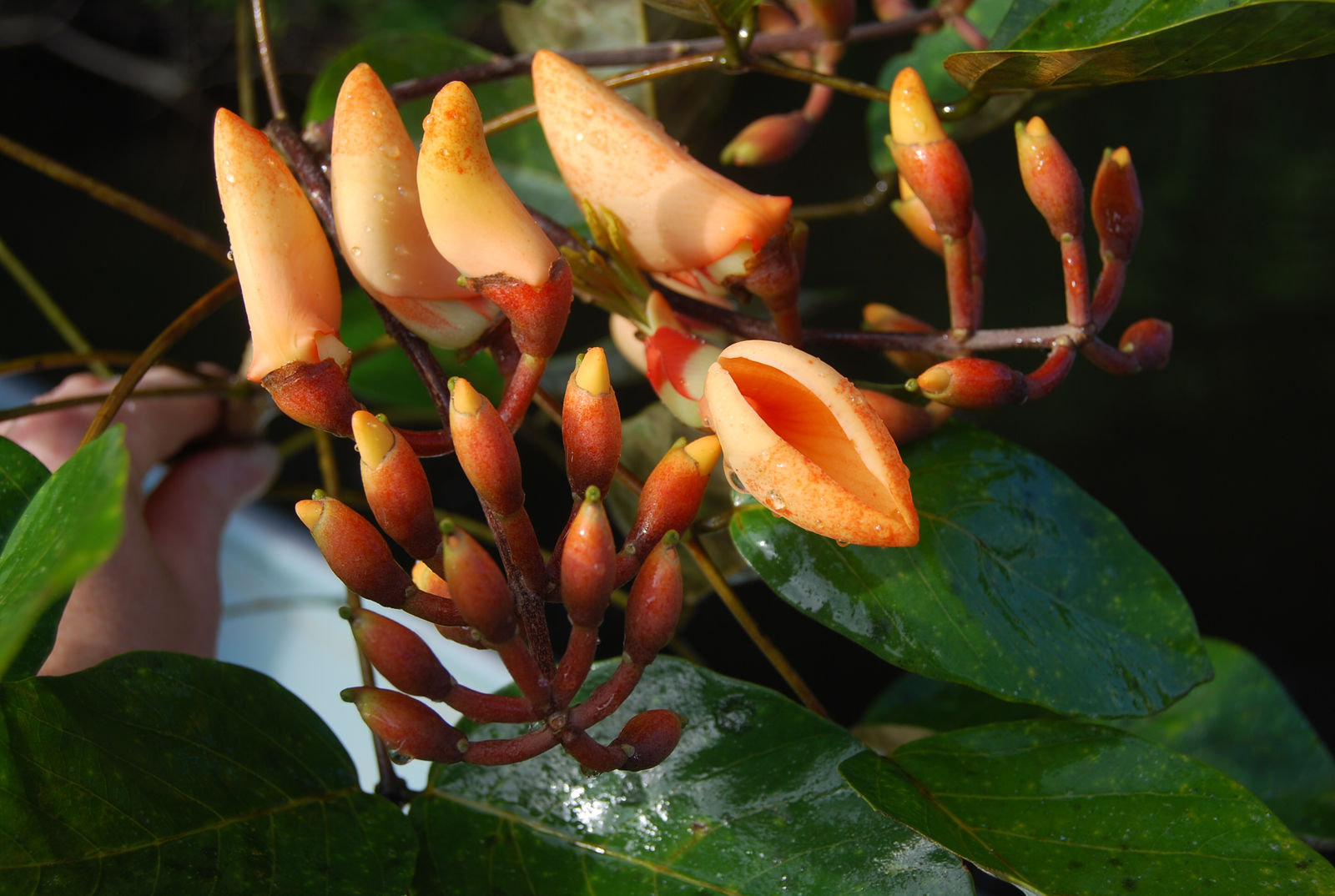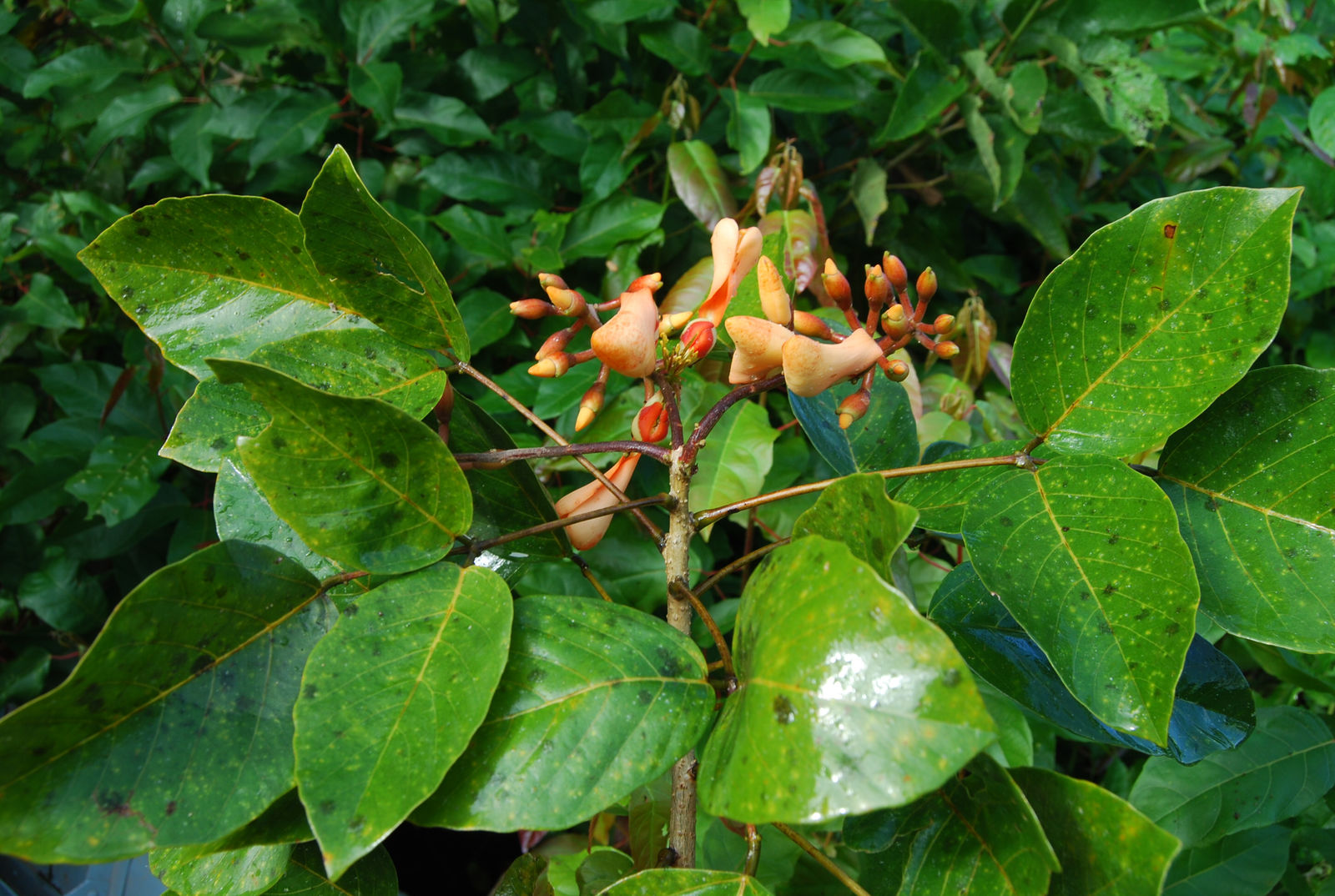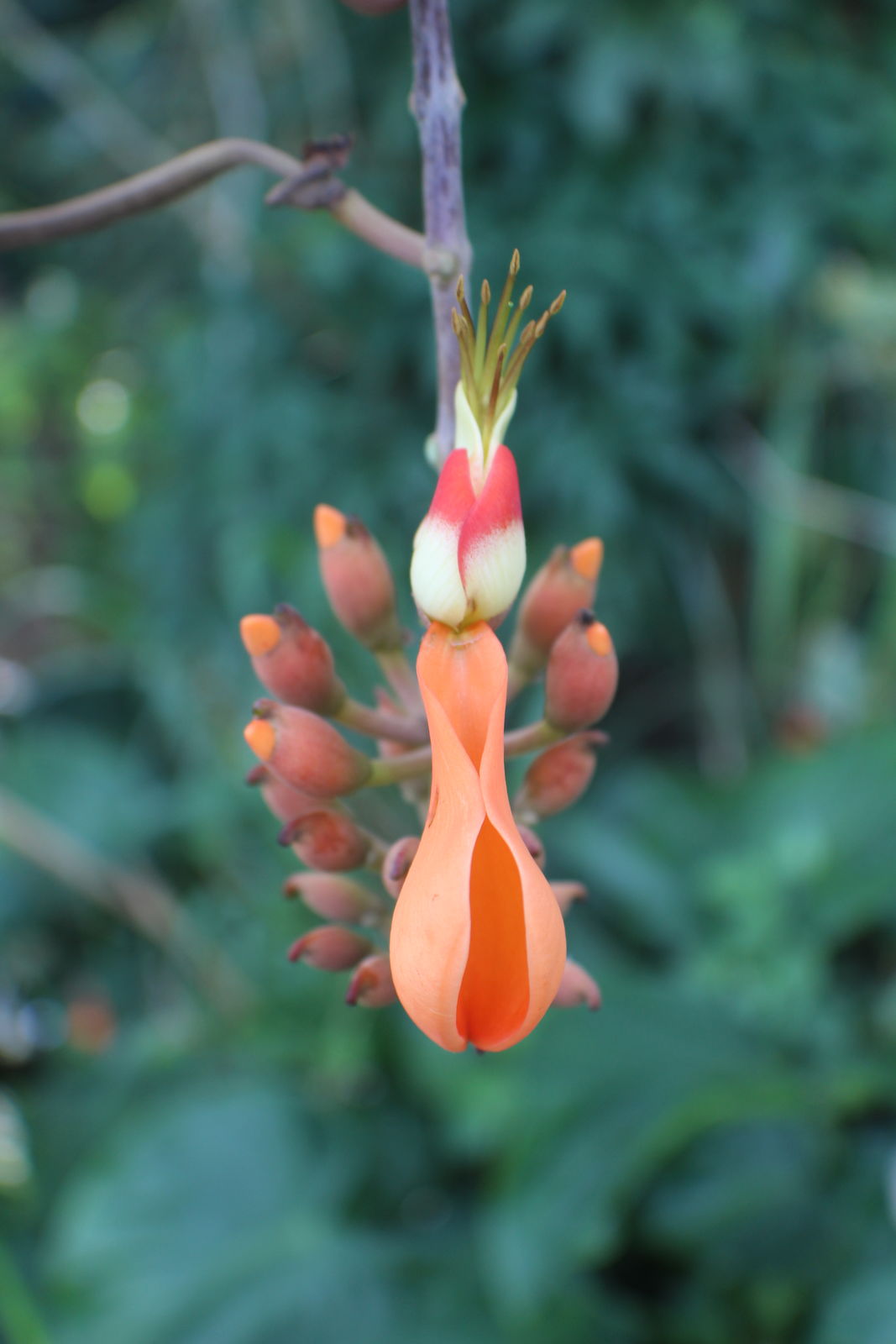Family: Fabaceae
Author: Lour.
Bibliography: Fl. Cochinch.: 427 (1790)
Year: 1790
Status: accepted
Rank: species
Genus: Erythrina
Vegetable: False
Observations: Trop. America, Tanzania (Pemba) to W. Pacific
Description
The Coral-bean, known scientifically as Erythrina fusca and first referenced in the Flora Cochinchinese (1790) by Loureiro, is a remarkable member of the Fabaceae family. This plant is native to tropical regions of America and has also been observed in diverse locations spanning from Tanzania, specifically Pemba, to various parts of the Western Pacific.
Erythrina fusca is distinguished by its vivid and striking flowers, which contribute to its common name, Coral-bean. These flowers are typically an eye-catching red or orange, forming ornate clusters that are not only a visual delight but also attract hummingbirds and other pollinators. The vibrant blooms are set against pinnate leaves, adding to the plant’s ornamental appeal.
In addition to its aesthetic value, the Coral-bean has practical applications in traditional medicine across its native regions. Various parts of the plant, including the seeds and bark, have been utilized for their purported antibacterial and anti-inflammatory properties. However, it should be noted that, like many members of the Fabaceae family, parts of the Erythrina fusca are toxic if ingested improperly.
The Coral-bean thrives in tropical climates, often found near water bodies such as rivers and swamps, which supports its need for moist, well-drained soils. It prefers regions with rich organic content and can grow as a shrub or a tree, reaching impressive heights under optimal conditions.
Cultivators value the Coral-bean not only for its beauty and medicinal qualities but also for its ecological benefits. The plant engages in nitrogen fixation, enriching the soil and supporting the growth of surrounding flora. This nitrogen-fixing capability is a notable characteristic shared by many Fabaceae species, making Erythrina fusca an excellent choice for sustainable landscaping and agricultural practices.
In conclusion, the Coral-bean (Erythrina fusca) is a multifaceted plant known for its striking floral displays, medicinal uses, and ecological contributions. Its presence from the tropical Americas to the Western Pacific demonstrates its adaptability and the broad appeal of its natural benefits.
Common Names
Spa: ahuijote, bucago, bucare, bucayo, gallito de pantano, palo santo
Por: alecrim, sananduva, suinã
Eng: coral-bean, purple coraltree, swamp immortelle
Khm: រលួសផ្អុង
En: Coral-bean, Purple coraltree, Swamp immortelle, Bucayo, Kaffirboom, Cape Kaffirboom, Sand coker, Swamp Imortelle, Ahuijote, Bucago, Gallito de pantano, Lucky beantree
Bn: কাঁটা মান্দার
Zh: 褐花刺桐
Fi: Loimukorallipuu
Fr: Bocare, Zimmortelle
Id: Cangkring
Jv: Cangkring
Km: រលួសផ្អុង
Fa: فردوسی ارغوانی
Pt: Alecrim, Sananduva, Suinã, Açacurana
Qu: Mayu amasisa
Es: Ahuijote, Palo santo, Bucago, Bucare, Gallito de pantano, Bucayo
Su: Cangkring
Th: ทองหลางน้ำ
Uk: Ерітрина бура
Vi: Đậu san hô đỏ
Synonyms
- Corallodendron patens ((Moc. & Sessé ex DC.) Kuntze)
- Erythrina glauca (Willd.)
- Corallodendron ovalifolium ((Roxb.) Kuntze)
- Erythrina fusca var. inermis (Pulle)
- Erythrina atrosanguinea (Ridl.)
- Erythrina patens (Moc. & Sessé ex DC.)
- Erythrina argentea (Blume ex Miq.)
- Erythrina ovalifolia (Roxb.)
- Corallodendron fuscum ((Lour.) Kuntze)
- Erythrina moelebei (Vieill. ex Guillaumin & Beauvis.)
- Duchassaingia glauca ((Willd.) Walp.)
- Corallodendron glaucum ((Willd.) Kuntze)
- Duchassaingia ovalifolia ((Roxb.) Walp.)
Distribution
- Andaman Is. (native)
- Assam (native)
- Bangladesh (native)
- Belize (native)
- Bismarck Archipelago (native)
- Bolivia (native)
- Borneo (native)
- Brazil North (native)
- Brazil Northeast (native)
- Brazil Southeast (native)
- Brazil West-Central (native)
- Cambodia (native)
- Caroline Is. (native)
- Central American Pac (native)
- Colombia (native)
- Comoros (native)
- Costa Rica (native)
- Cuba (native)
- Dominican Republic (native)
- Ecuador (native)
- El Salvador (native)
- Fiji (native)
- French Guiana (native)
- Guatemala (native)
- Guyana (native)
- Honduras (native)
- India (native)
- Jawa (native)
- Laos (native)
- Leeward Is. (native)
- Madagascar (native)
- Malaya (native)
- Maluku (native)
- Myanmar (native)
- New Caledonia (native)
- New Guinea (native)
- Nicaragua (native)
- Panamá (native)
- Peru (native)
- Philippines (native)
- Puerto Rico (native)
- Queensland (native)
- Samoa (native)
- Solomon Is. (native)
- Sri Lanka (native)
- Sulawesi (native)
- Sumatera (native)
- Suriname (native)
- Tanzania (native)
- Thailand (native)
- Tonga (native)
- Trinidad-Tobago (native)
- Vanuatu (native)
- Venezuela (native)
- Vietnam (native)
- Windward Is. (native)
- Cameroon (introduced)
- Ghana (introduced)
- Gulf of Guinea Is. (introduced)
- Lesser Sunda Is. (introduced)
- Mauritius (introduced)
- Nigeria (introduced)
- Réunion (introduced)
- Uganda (introduced)
- Zambia (introduced)
Additional Images
Leaf
Taken Aug 16, 2019 by Coordination Endemia (cc-by-sa)
Taken Jan 20, 2020 by Antonella (cc-by-sa)
Taken Jan 4, 2022 by Garcia-Q. Hector (cc-by-sa)
Taken Jan 4, 2022 by Garcia-Q. Hector (cc-by-sa)
Taken Nov 12, 2021 by Quijano David (cc-by-sa)
Other
Taken Oct 28, 2008 by AMAP Lab – Guyane 2022 (cc-by-sa)
Taken Oct 28, 2008 by AMAP Lab – Guyane 2022 (cc-by-sa)
Taken Oct 28, 2008 by AMAP Lab – Guyane 2022 (cc-by-sa)
Taken Oct 28, 2008 by AMAP Lab – Guyane 2022 (cc-by-sa)
Taken Oct 28, 2008 by AMAP Lab – Guyane 2022 (cc-by-sa)
Flower
Taken Sep 25, 2009 by Endemia – Jacques Bottet (cc-by-nc)
Taken Oct 24, 2021 by Maquiavelito (cc-by-sa)
Taken Mar 9, 2020 by Cyril Pron (cc-by-sa)
Taken Apr 6, 2021 by Julian Maya (cc-by-sa)
Taken Feb 28, 2022 by Kiran Muppalla (cc-by-sa)
Habit
Taken Jan 1, 1970 by Endemia – Alexandre Cherrier (cc-by-nc)
Taken Jan 1, 1970 by Endemia – Alexandre Cherrier (cc-by-nc)
Taken Jan 1, 1970 by Endemia – Benoît Henry (cc-by-nc)
Taken Nov 2, 2013 by Endemia – Benoît Henry (cc-by-nc)
Taken Jan 1, 1970 by Endemia – Alexandre Cherrier (cc-by-nc)
Fruit
Taken Jan 1, 1970 by Endemia – Benoît Henry (cc-by-nc)
Taken Jan 1, 1970 by Endemia – Benoît Henry (cc-by-nc)
Taken Sep 1, 2008 by Endemia – Jacques Bottet (cc-by-nc)
Taken Nov 2, 2013 by Endemia – Benoît Henry (cc-by-nc)
Taken Apr 8, 2010 by OTS – Oviedo-Brenes, Federico (cc-by-nc-sa)
Bark
Taken Jan 27, 2020 by dan hewison (cc-by-sa)
Taken Jan 1, 1970 by Endemia – Alexandre Cherrier (cc-by-nc)
Taken Jan 1, 1970 by Endemia – Alexandre Cherrier (cc-by-nc)

© copyright of the Board of Trustees of the Royal Botanic Gardens, Kew.

© copyright of the Board of Trustees of the Royal Botanic Gardens, Kew.

© copyright of the Board of Trustees of the Royal Botanic Gardens, Kew.
Sources
- POWO (http://powo.science.kew.org/taxon/urn:lsid:ipni.org:names:494431-1)
- GBIF (https://www.gbif.org/species/5349620)
- PlantNet (https://identify.plantnet.org/species/the-plant-list/Erythrina fusca Lour.)
- WFO (No URL)
- IPNI (No URL)
Specifications
Growth habit>: Tree




























